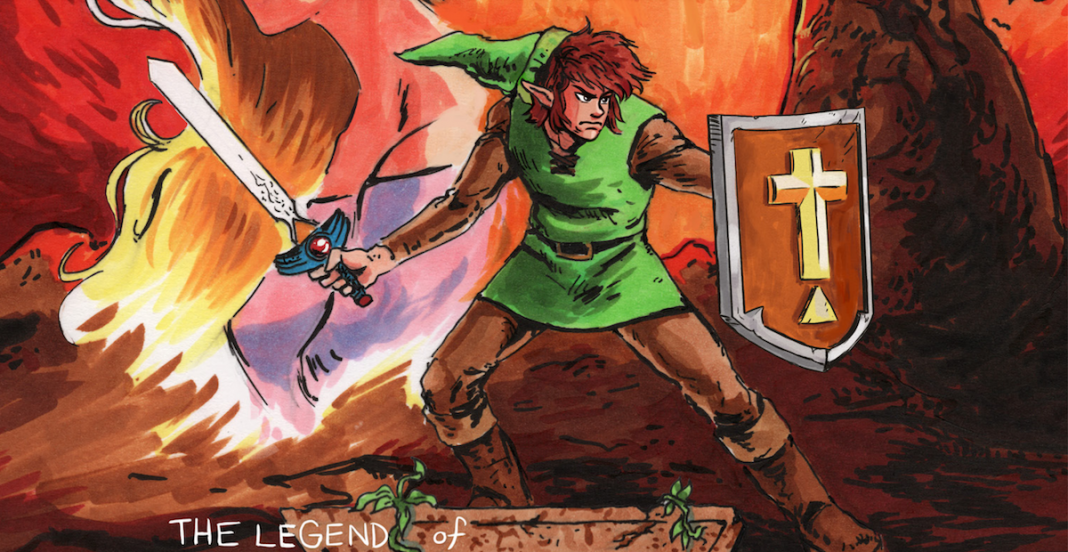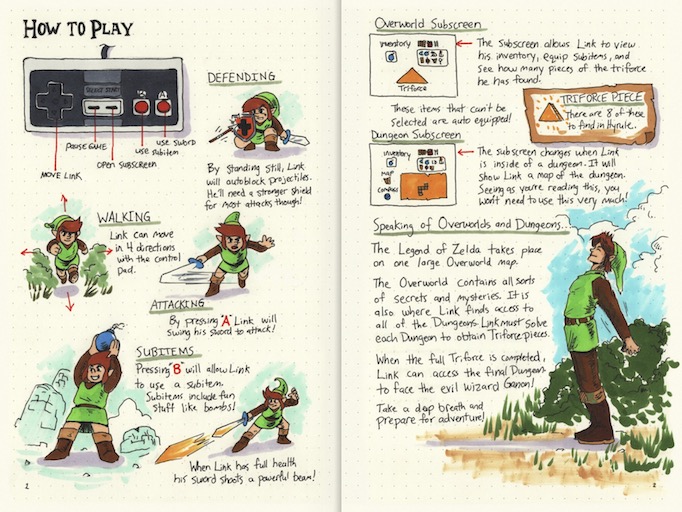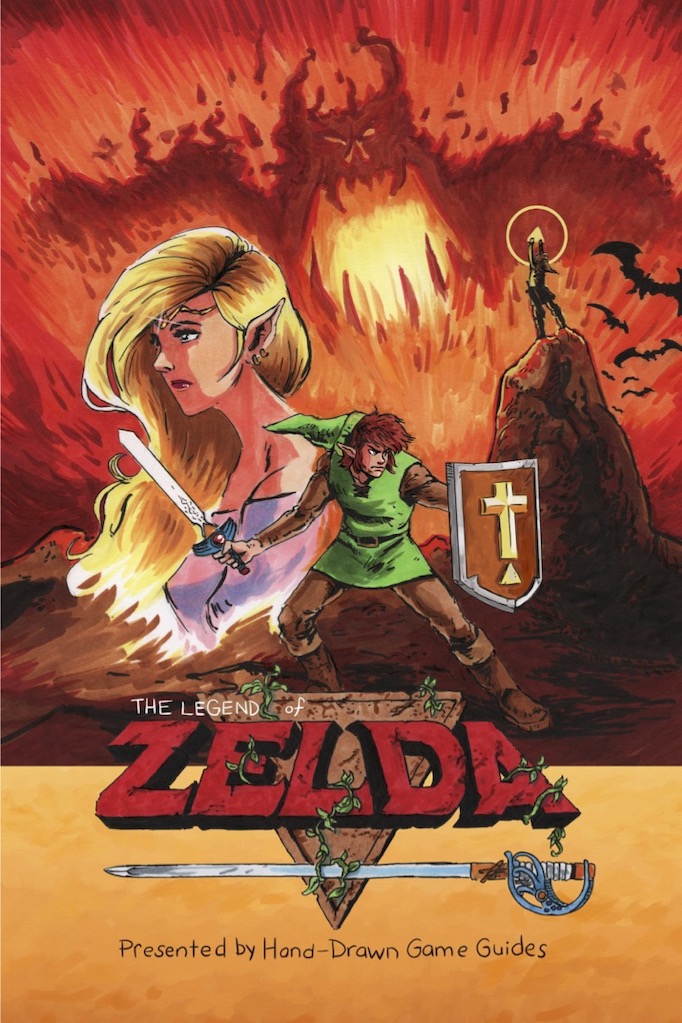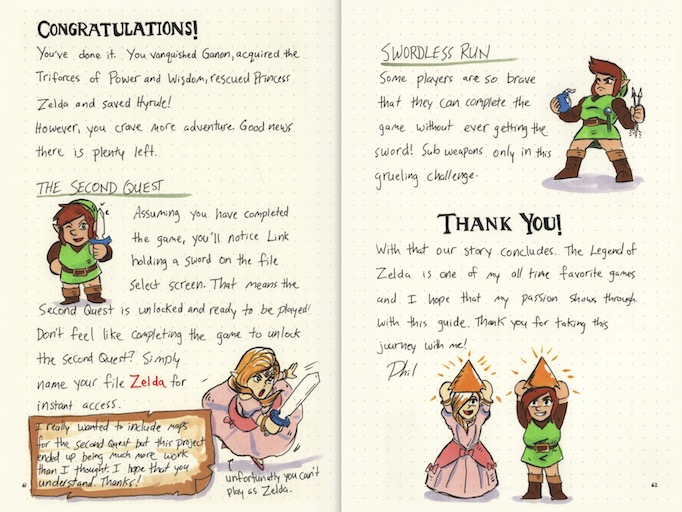Nostalgia is a hell of a drug, especially during a time in our lives when we want to be reminded of things that feel safe and familiar. It’s a big reason why the direct market is still controlled by the superheroes we read about as children. The video game community, similarly, will always be attached to the games they grew up with.
Nostalgia probably played a role in the success of Philip Summers’ Hand-Drawn Game Guides. His lovingly illustrated recreations of guides for classic NES games like The Legend of Zelda and Ninja Gaiden caught on in a big way, with print copies selling out just minutes after becoming available.
I reached out to Philip to discuss how came up with the idea for the hand-drawn game guides, infusing his passion for video games into them, and the creative value of fan art.
Can you describe your background as an artist?
I’ve been drawing my whole life, went to art school in Philly for animation and from there I somehow turned into a graphic artist. I work full time as a UX/UI designer. Outside of the office, I’m usually working on some kind of creative project. I did animation for YouTube for several years, then started focusing more on illustration.
What originally interested you in recreating NES game guides?
I had a desire to come up with a project I could work on that didn’t involve looking at a computer screen. I also realized that for almost a decade all of my art was digital-only. I had nothing tangible and I missed that. So I thought about making a small strategy guide for a game, filled with lots of character art and all the stage maps. I started with Contra because it’s one of my favorites and it’s an extremely short game so I thought it would be manageable to work on. Once I became involved with it, it ended up being a larger project than I thought, but I got really into it and found myself coming up with character bios, and showing basics like how the game is actually played and works.
What is it about those classic guides that make them so special?
I think the old guides and older magazines like Nintendo Power have stuck with people my age because that was it. That was your access to finding out about a game, or figuring out how to play or finish the game. It helped that generally these books were filled with lots of genuinely awesome artwork. You weren’t able to just look up a FAQ on GameFAQs, watch a YouTube video for help, or be bombarded with news about future releases. People simply had those old books and the occasional VHS tape. The options were much more limited, so what was available mattered more. At least I think that’s a big part of it.
It seems like there are more artistic interpretations of characters like Mario and Link than almost anyone else in fiction. Do you think there’s something about video games and Nintendo properties in particular that makes them especially well-suited for fan art?
Now that we’re several decades into this whole video game thing, characters like Mario, Link, Sonic, and Pikachu are proven to be timeless. Many of the people drawing these characters have grown up with them, whether or not The Legend of Zelda, or Ocarina of Time, or even Twilight Princess was their first Zelda game. These games continue to make a mark on the people that play them each generation. These enduring franchises are made by some of the most creative minds, and their creativity inspires others to be creative in their own ways.
What do you think makes fans so excited about the characters, when we’re told so little about them through the games themselves?
I think the answer to your question resides in the question itself. Characters like Mario and Link are blank slates, and they’re intentionally blank slates. They don’t look like us, but that makes it much easier for us to assume the role of that character and we in turn can put our own traits and thoughts into what these characters are and can be. Link and Mario don’t talk beyond the usual grunts and yahoos because the moment they speak, we lose our own voice in that character. Once they have their own personality and clearly defined thoughts and emotions, the “link” to them as an extension of us is broken. My thought is that because of this, we’re able to connect with these characters on a different level than say a fully written and fleshed out character that leaves no room for our own interpretation.
What are some of your favorite pieces of video game art created by other artists?
Dave Rapoza absolutely kills it. If we’re talking official video game artwork, Katsuya Terada is just fantastic. His work was such a huge inspiration for the Zelda guide. My original thought going into Zelda was that I wanted to make a book that looked like something he’d have worked on, along with conjuring up images of the old Zelda manual. I printed loads of thumbnails of Terada’s artwork and would surround myself with them whenever I worked on Zelda. I used it as an opportunity to study his approach to illustrating. He did some incredible work for so many games and it was a great experience just soaking in his style to the best of my ability.
How did the Hand-Drawn Game Guides originally gain attention? Was a specific outlet responsible for making them explode in popularity?
I went the traditional route of just trying to make a little noise. I sent PDF copies of Contra to media outlets and was featured on Nintendolife.com and GoNintendo.com. Contra did well and I was happy with it, but Ninja Gaiden was just a much better book. When I sent that around to outlets more of them picked it up and it had more attention than Contra. I worked Ninja Gaiden’s launch into its 30th anniversary of the game and dropped it the day they released the NES version of the game on Switch. So the timing on that was perfect while Ninja Gaiden was briefly on people’s minds again.
With Zelda, well, Zelda is way more popular so as I worked on it over the course of a year and shared progress people started getting on board with it. Since I was launching with a limited amount of physical copies, I could get some physical copies into people’s hands before release and that was really a game-changer. These books were always meant to be digital-only, but once people had Zelda books in their hands things changed. I realized people valued having a tangible book in their hands for the same reason I wanted to make something tangible for myself. It just feels a little more personal.
I see you on Twitter responding to individual customers to keep them updated on the shipping status of their books. Has selling the guides turned into a significant time commitment?
Yes, it’s been a major time commitment running the “customer service” side of things, but it’s been worth it. I haven’t even been able to touch the follow-up book yet because I’ve been knee-deep in meeting demand over the last few months. I’m learning a lot about order fulfillments, working with printers, shipping, and all the sort of things that go along with the production side of things. I legitimately wasn’t prepared to handle this part of it going into it, so it has been a learning experience. I try my hardest to be as transparent as possible with people. People are trusting me to deliver on my end of the transaction, and I feel like, once money exchanges hands, I need to give them everything I got. So I try to keep communication open and answer emails and questions as soon as I can.
Where do you find time for everything you’re working on?
By not doing lots of other things. I don’t watch much TV, sometimes I fall behind on chores around the house, sometimes I don’t go out as much as I should. In the case of preparing for the last physical run of books, I took off of work for a week. Everything we do as an adult is give-and-take, but I’ve had lots of side hobbies that demand plenty of time for many years now so I’m used to adjusting. I don’t work nonstop though if that were the case I could have finished drawing Zelda in half the time!
What do you have planned next? Are you creating a fourth entry in your series of Hand-Drawn Game Guides, or do you have other projects in the works?
Yes, I’ll be working on a fourth book. I’m dying to tackle the original Metroid next. I already have loads of ideas, but I want to get through this last wave of shipments on the physical books and spend most of December being about as lazy as possible and just enjoy the holidays as best we’re able to right now.
Follow Philip on Twitter @heyphilsummers. You can buy digital versions of the Hand-Drawn Game Guides or sign up to be notified when more print copies become available here.











